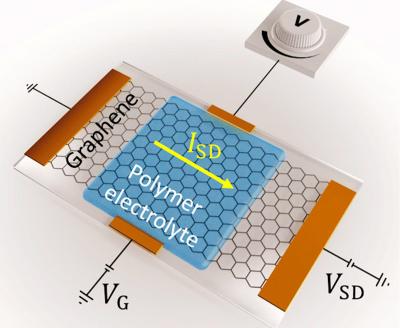A team of researchers from Bielefeld and Berlin, together with researchers from other research institutes in Germany and Spain, recently demonstrated that graphene's nonlinearity can be efficiently controlled by applying comparatively modest electrical voltages to the material.
 The gated graphene sample device in which the graphene film acts as a channel between source and drain electrodes subjected to a constant potential difference of 0.2 mV. Image from Science Advances
The gated graphene sample device in which the graphene film acts as a channel between source and drain electrodes subjected to a constant potential difference of 0.2 mV. Image from Science Advances
It was recently discovered that the high electronic conductivity and "massless" behavior of graphene's electrons allows it to alter the frequency components of electric currents that pass through it. This property is highly dependent on how strong this current is. In modern electronics, such a nonlinearity comprises one of the most basic functionalities for switching and processing of electrical signals. What makes graphene unique is that its nonlinearity is by far the strongest of all electronic materials. Moreover, it works very well for exceptionally high electronic frequencies, extending into the technologically important terahertz (THz) range where most conventional electronic materials fail.
"This is a significant step forward towards implementation of graphene in electrical signal processing and signal modulation applications," says Prof. Dmitry Turchinovich, a physicist at Bielefeld University and one of the heads of this study. "Earlier we had already demonstrated that graphene is by far the most nonlinear functional material we know of. We also understand the physics behind nonlinearity, which is now known as thermodynamic picture of ultrafast electron transport in graphene. But until now we did not know how to control this nonlinearity, which was the missing link with respect to using graphene in everyday technologies."
"By applying the control voltage to graphene, we were able to alter the number of electrons in the material that can move freely when the electrical signal is applied to it," explains Dr. Hassan A. Hafez, a member of Professor Dr. Turchinovich's lab in Bielefeld, and one of the lead authors of the study. "On one hand, the more electrons can move in response to the applied electric field, the stronger the currents, which should enhance the nonlinearity. But on the other hand, the more free electrons are available, the stronger the interaction between them is, and this suppresses the nonlinearity. Here we demonstrated - both experimentally and theoretically - that by applying a relatively weak external voltage of only a few volts, the optimal conditions for the strongest THz nonlin-earity in graphene can be created."
"With this work, we have reached an important milestone on the path towards to using graphene as an extremely efficient nonlinear functional quantum material in devices like THz frequency converters, mixers, and modulators," says Professor Dr. Michael Gensch from the Institute of Optical Sensor Systems of the German Aerospace Center (DLR) and the Technical University of Berlin, who is the other head of this study. "This is extremely relevant because graphene is perfectly compatible with existing electronic ultrahigh-frequency semiconductor technology such as CMOS or Bi-CMOS. It is therefore now possible to envision hybrid devices in which the initial electric signal is generated at lower frequency using existing semiconductor technology but can then very efficiently be up-converted to much higher THz frequencies in graphene, all in a fully controllable and predictable manner."